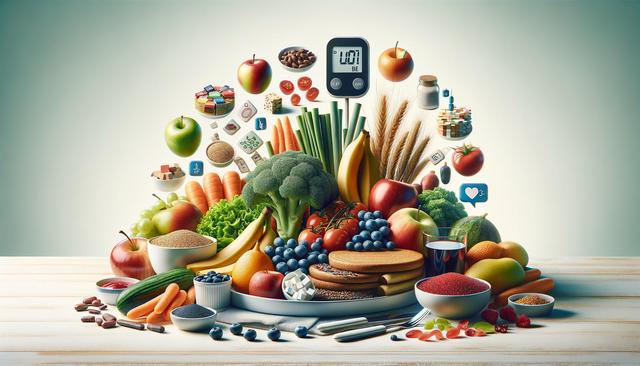Understanding the Role of Diet in Blood Sugar Regulation
One of the most effective strategies for managing blood sugar is through a well-balanced diet. The foods we consume play a critical role in how our body processes glucose, and certain dietary patterns can significantly improve regulation. When exploring how to lower blood sugar fast, it’s important to focus on meals that are low in refined carbohydrates and sugars, and rich in fiber and protein. These nutrients help slow down the absorption of glucose into the bloodstream, reducing sudden spikes.
Key dietary principles for blood sugar control include:
- Choosing whole grains over refined grains
- Increasing intake of non-starchy vegetables
- Incorporating healthy fats such as olive oil, nuts, and seeds
- Opting for lean protein sources like fish, poultry, and legumes
Understanding what to eat to keep blood sugar normal is essential for those managing diabetes or simply aiming for better metabolic health. By prioritizing nutrient-dense foods and minimizing processed items, individuals can support a steadier glucose response throughout the day.
Low Glycemic Index Foods and Their Benefits
The glycemic index (GI) measures how quickly a food raises blood sugar levels. Foods with a low GI are digested more slowly, causing a gradual rise in blood glucose. Incorporating low-GI foods into your diet is a practical approach when considering how to keep blood sugar normal on a daily basis. Examples include legumes, whole oats, quinoa, and most fruits and vegetables.
Some low-GI foods to consider adding to meals:
- Sweet potatoes
- Lentils and beans
- Apples, berries, and oranges
- Leafy greens and cruciferous vegetables
Recipes to lower blood sugar often emphasize these ingredients, pairing them in ways that enhance flavor while supporting health. For instance, a quinoa salad with chickpeas, spinach, and avocado makes for a satisfying and blood sugar-friendly lunch. These types of meals provide essential nutrients while helping to keep glucose levels within a healthy range.
Meal Timing and Portion Control
In addition to food choices, when and how much you eat can have a significant impact on blood sugar stability. Regularly spaced meals can help prevent extreme highs and lows. Skipping meals, on the other hand, may lead to overeating later in the day, which can cause blood sugar spikes. Practicing portion control and mindful eating are effective components of a blood sugar management plan.
Consider these guidelines for meal planning:
- Eat small, balanced meals every 3 to 5 hours
- Limit portion sizes of carbohydrate-rich foods
- Include a source of fiber, protein, and healthy fat in each meal
Understanding how to lower blood sugar also involves being aware of food combinations. For example, combining carbohydrates with protein or fat can reduce the glycemic impact of a meal. This strategy helps maintain more consistent glucose levels and supports long-term metabolic health.
Beneficial Nutrients and Supplements
While diet is the foundation of blood sugar control, certain vitamins and minerals may also support healthy glucose metabolism. A vitamin for lowering blood sugar is not a substitute for dietary changes, but some nutrients have been associated with improved insulin sensitivity and glycemic control. These include magnesium, chromium, vitamin D, and certain antioxidants.
Some commonly studied supplements include:
- Magnesium: May support insulin action and glucose regulation
- Alpha-lipoic acid: An antioxidant that may help reduce oxidative stress and improve glucose uptake
- Chromium picolinate: Might aid in enhancing insulin function
- Vitamin D: Low levels have been linked to impaired glucose tolerance
It is important to consult with a healthcare provider before starting any supplementation, especially for those already on medication or managing chronic conditions. Supplements can be a helpful addition to a diet rich in whole foods, but they should not replace the foundational role of nutrition and lifestyle in managing blood sugar.
Practical Meal Ideas for Blood Sugar Support
Creating meals that support blood sugar balance doesn’t have to be complicated. Focusing on simple, whole-food ingredients can make a big difference. Recipes to lower blood sugar often incorporate a variety of vegetables, lean proteins, whole grains, and healthy fats. These meals not only help regulate glucose but also contribute to overall wellness.
Here are a few meal ideas to consider:
- Breakfast: Vegetable omelet with avocado and a side of berries
- Lunch: Grilled chicken salad with kale, walnuts, and olive oil dressing
- Dinner: Baked salmon with roasted Brussels sprouts and sweet potato
- Snack: Greek yogurt with chia seeds and sliced almonds
Knowing how to lower blood sugar doesn’t mean eliminating entire food groups. Instead, it’s about making informed choices, balancing macronutrients, and enjoying a variety of foods that nourish the body. With consistency and planning, these changes can lead to more stable energy levels and improved long-term health outcomes.
Conclusion: Building Sustainable Habits for Blood Sugar Control
Managing blood sugar effectively involves more than just avoiding sugar; it requires a comprehensive approach that includes smart food choices, mindful eating, and the right nutrients. Whether you’re exploring how to lower blood sugar fast in acute situations or seeking sustainable ways to keep levels normal, adopting a balanced diet and consistent routine is key. Understanding what to eat to keep blood sugar normal empowers individuals to take control of their health and reduce the risk of complications. With the help of well-researched strategies and nutrient-rich recipes to lower blood sugar, lasting improvements are within reach.



Leave a Reply